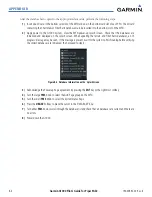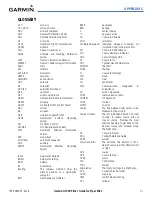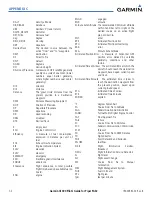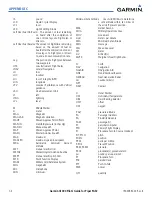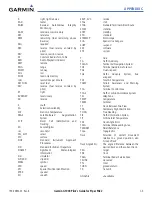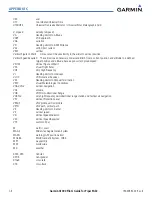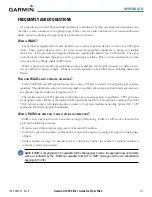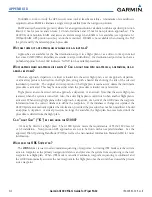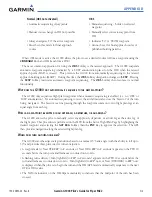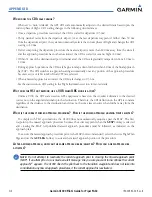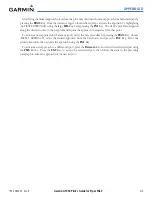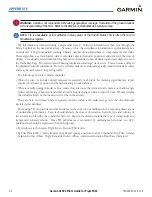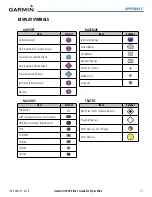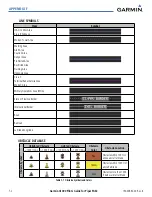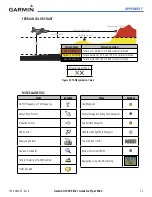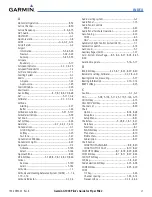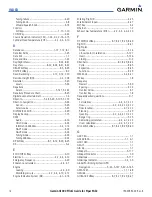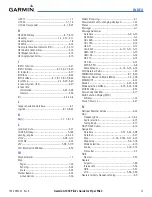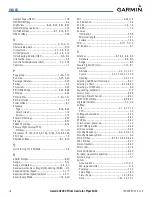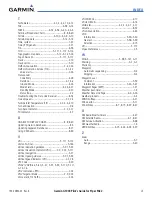
190-00692-00 Rev. B
Garmin G1000 Pilot’s Guide for Piper PA32
E-2
APPENDIX E
WARNING
:
Garmin is not responsible for Mode S geographical coverage. Operation of the ground stations
is the responsibility of the FAA. Refer to the AIM for a Terminal Mode S radar site map.
NOTE
:
TIS is unavailable at low altitudes in many areas of the United States. This is often the case in
mountainous regions.
TIS information is collected during a single radar sweep. Collected information is then sent through the
Mode S uplink on the next radar sweep. Because of this, the surveillance information is approximately five
seconds old. TIS ground station tracking software uses prediction algorithms to compensate for this delay.
These algorithms use track history data to calculate expected intruder positions consistent with the time of
display. Occasionally, aircraft maneuvering may cause variations in this calculation and create slight errors on
the Traffic Map Page. Errors affect relative bearing information and target track vector. This can cause a delay in
the displayed intruder information. However, intruder distance and altitude typically remain relatively accurate
and may be used to assist in spotting traffic.
The following errors are common examples:
• When the client or intruder aircraft maneuvers excessively or abruptly, the tracking algorithm may report
incorrect horizontal position until the maneuvering aircraft stabilizes.
• When a rapidly closing intruder is on a course that intercepts the client aircraft course at a shallow angle
(either overtaking or head-on) and either aircraft abruptly changes course within 0.25 nm, TIS may display
the intruder aircraft on the incorrect side of the client aircraft.
These are rare occurrences and are typically resolved within a few radar sweeps once the client/intruder
aircraft course stabilizes.
Pilots using TIS can provide valuable assistance in the correction of malfunctions by reporting observations
of undesirable performance. Reports should identify the time of observation, location, type and identity of
the aircraft, and describe the condition observed. Reports should also include the type of transponder and
transponder software version. Since TIS performance is monitored by maintenance personnel, not ATC,
malfunctions should be reported in the following ways:
• By telephone to the nearest Flight Service Station (FSS) facility
• By FAA Form 8000-7, Safety Improvement Report (postage-paid card can be obtained at FAA FSSs, General
Aviation District Offices, Flight Standards District Offices, and General Aviation Fixed Base Operators)
Содержание G1000:Piper
Страница 1: ...Piper PA32...
Страница 50: ...190 00692 00 Rev B Garmin G1000 Pilot s Guide for Piper PA32 1 40 SYSTEM OVERVIEW BLANK PAGE...
Страница 80: ...Garmin G1000 Pilot s Guide for Piper PA32 190 00692 00 Rev B 2 30 FLIGHT INSTRUMENTS BLANK PAGE...
Страница 94: ...Garmin G1000 Pilot s Guide for Piper PA32 190 00692 00 Rev B 3 14 ENGINE INDICATION SYSTEM BLANK PAGE...
Страница 134: ...190 00692 00 Rev B Garmin G1000 Pilot s Guide for Piper PA32 4 40 AUDIO PANEL AND CNS BLANK PAGE...
Страница 249: ...GPS NAVIGATION 190 00692 00 Rev B 5 115 Garmin G1000 Pilot s Guide for Piper PA32 Figure 5 121 Approaching PYNON...
Страница 254: ...GPS NAVIGATION 190 00692 00 Rev B 5 120 Garmin G1000 Pilot s Guide for Piper PA32 Figure 5 129 Hold Established...
Страница 352: ...Garmin G1000 Pilot s Guide for Piper PA32 190 00692 00 Rev B 7 2 AUTOMATIC FLIGHT CONTROL SYSTEM BLANK PAGE...
Страница 438: ...190 00692 00 Rev B Garmin G1000 Pilot s Guide for Piper PA32 D 6 APPENDIX D BLANK PAGE...
Страница 444: ...190 00692 00 Rev B Garmin G1000 Pilot s Guide for Piper PA32 F 4 APPENDIX F BLANK PAGE...
Страница 450: ...Garmin G1000 Pilot s Guide for Piper PA32 190 00692 00 Rev B I 6 INDEX BLANK PAGE...

